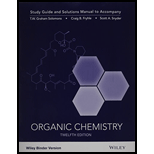
Concept explainers
Deduce the structures of compounds A, B, and C, which all have the formula
the only organic product that can be isolated is  . Similar oxidation of B gives only
. Similar oxidation of B gives only  , and similar treatment of C gives only
, and similar treatment of C gives only  .
.
Want to see the full answer?
Check out a sample textbook solution
Chapter 8 Solutions
Organic Chemistry, 12e Binder Ready Version Study Guide / Student Solutions Manual
Additional Science Textbook Solutions
Chemistry: Structure and Properties
Chemistry: The Central Science (14th Edition)
Chemistry
Chemistry & Chemical Reactivity
CHEMISTRY-TEXT
General, Organic, and Biological Chemistry: Structures of Life (5th Edition)
- Compound I (C11H14O2) is insoluble in water, aqueous acid, and aqueous NaHCO3, but dissolves readily in 10% Na2CO3 and 10% NaOH. When these alkaline solutions are acidified with 10% HCl, compound I is recovered unchanged. Given this information and its 1H-NMR spectrum, deduce the structure of compound I.arrow_forwardA solution of acetone [(CH3)2C=O] in ethanol (CH3CH2OH) in the presence of a trace of acid was allowed to stand for several days, and a new compound of molecular formula C7H16O2 was formed. The IR spectrum showed only one major peak in the functional group region around 3000 cm−1, and the 1H NMR spectrum is given here. What is the structure of the product?arrow_forwardThe IR, and 1H NMR spectra of a compound with formula C5H6O2 are shown below. Determine the structure of the compound. You must fill all the parts to this question in the given spaces.arrow_forward
- Use the 1H NMR and IR spectra given below to identify the structure of compound B (molecular formula C4H8O2).arrow_forwardCompound A, C8H10O, has the IR and 1H NMR spectra shown. Propose a structure consistent with the observed spectra, and label each peak in the NMR spectrum. Note that the absorption at 5.5 î disappears when D2O is added.arrow_forwardPropose a structure for compound X (molecular formula C6H12O2), which gives a strong peak in its IR spectrum at 1740 cm−1. The 1H NMR spectrum of X shows only two singlets, including one at 3.5 ppm. The 13C NMR spectrum is given below. Propose a structure for X.arrow_forward
- An unknown compound has a molecular formula of C4H6O2. Its IR spectrum shows absorptions at 3095, 1762, 1254, and 1118 cm -1. It exhibits the following signals in its 1H NMR spectrum (ppm): 2.12 (singlet,3H), 4.55 (doublets of doublets, 1H), 4.85 (doublet of doublets, 1H), 7.25 (doublets of doublets, 1H); and the following signals in its 13C NMR spectrum (ppm): 20.8, 100.4, 141.2, 168.0. Draw the structure of the unknown compoundarrow_forward2. DEDUCE THE STRUCTURE FOR EACH COMPOUND WITH THE INDICATED MOLECULAR FORMULA AND THE 1H-NMR AND IR SPECTRA PROVIDED. Formula: C5H10Oarrow_forwardIdentify products A and B from the given 1H NMR data. Treatment of acetone [(CH3)2C=O] with dilute aqueous base forms B. Compound B exhibits four singlets in its 1H NMR spectrum at 1.3 (6 H), 2.2 (3 H), 2.5 (2 H), and 3.8 (1H) ppm. What is the structure of B?arrow_forward
- Treatment of compound C (molecular formula C9H12O) with PCC affords D (molecular formula C9H10O). Use the 1H NMR and IR spectra of D to determine the structures of both C and D.arrow_forwardName the following compounds A and B. How could you distinguish these two molecules by using 1H NMR and IR techniques? Propose an analytical technique to determine the iron content of these compounds. Calculate the mass percentages of C and H of compound B (C: 12.01 g/mol; H: 1.008 g/mol; Fe: 55.845 g/mol).arrow_forwardCompound A of molecular formula C3H6O shows a noteworthy infrared absorption at 1716 cm-1. Its 1H-NMR spectrum shows one singlet – δ 2.2 (6H) ppm. Its 13C-NMR spectrum has two signals – δ 30, 207 ppm. Suggest a structure for this compound.arrow_forward
 Organic ChemistryChemistryISBN:9781305580350Author:William H. Brown, Brent L. Iverson, Eric Anslyn, Christopher S. FootePublisher:Cengage Learning
Organic ChemistryChemistryISBN:9781305580350Author:William H. Brown, Brent L. Iverson, Eric Anslyn, Christopher S. FootePublisher:Cengage Learning
